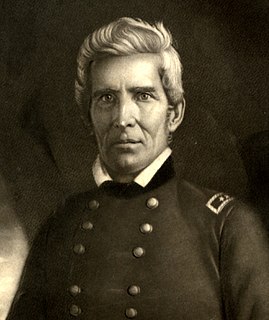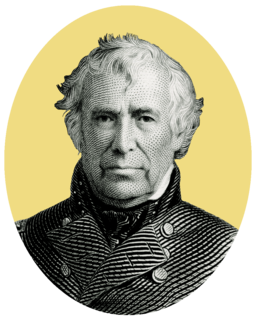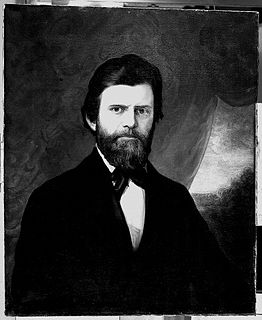
The Governor of Wisconsin is the highest executive authority in the government of the U.S. state of Wisconsin. The position was first filled by Nelson Dewey on June 7, 1848, the year Wisconsin became a state. Prior to statehood, there were four Governors of Wisconsin Territory.

John Young was an American politician. He served in the United States House of Representatives and as Governor of New York.

William Orlando Butler was a U.S. political figure and U.S. Army major general from Kentucky. He served as a Democratic congressman from Kentucky from 1839 to 1843, and was the Democratic vice-presidential nominee under Lewis Cass in 1848.

The 1848 Whig National Convention was a quadrennial presidential nominating convention of the Whig Party. The convention was held in Philadelphia. War hero Zachary Taylor, a major general from Louisiana with no political background, was nominated as the party's candidate for president. Former New York Representative Millard Fillmore was nominated for vice president. They won the 1848 presidential election, defeating the Democratic candidates Lewis Cass and William O. Butler.

The Lieutenant Governor of Wisconsin is the first person in the order of succession of Wisconsin's executive branch, thus serving as governor in the event of the death, resignation, removal, impeachment, absence from the state, or incapacity due to illness of the Governor of Wisconsin. The position was first filled by John Edwin Holmes on June 7, 1848, the year that Wisconsin became a state.

Daniel Russell Brown was an American politician and the 43rd Governor of Rhode Island.

The 1896 New York state election was held on November 3, 1896, to elect the Governor, the Lieutenant Governor and a judge of the New York Court of Appeals, as well as all members of the New York State Assembly. Besides, a constitutional amendment on forestry was proposed, and rejected with 321,486 votes for and 710,505 against it.

The 1848 New York state election took place on November 7, 1848 to elect the Governor, the Lieutenant Governor, a Canal Commissioner and an Inspector of State Prisons, as well as all members of the New York State Assembly.
The following table indicates the party of elected officials in Massachusetts:
The Liberty Party was a minor political party in the United States in the 1840s. The party was an early advocate of the abolitionist cause and it broke away from the American Anti-Slavery Society (AASS) to advocate the view that the Constitution was an anti-slavery document. William Lloyd Garrison, leader of the AASS, held the contrary view that the Constitution should be condemned as an evil pro-slavery document. The party included abolitionists who were willing to work within electoral politics to try to influence people to support their goals. By contrast, the radical Garrison opposed voting and working within the system. Many Liberty Party members joined the anti-slavery Free Soil Party in 1848 and eventually helped establish the Republican Party in the 1850s.
Albert Lester was an American lawyer and politician.
The 1849 United States Senate election in New York was held on February 6, 1849, by the New York State Legislature to elect a U.S. Senator to represent the State of New York in the United States Senate.
The United States Senate elections of 1848 and 1849 were elections which had the Democratic Party lose seats but maintain control of the United States Senate.
The Maine gubernatorial election, 1848, was an election held in 1848 in the state of Maine to decide Maine's next governor.

The Illinois gubernatorial election of 1848 was the ninth election for this office. Democratic governor Augustus C. French was easily re-elected. This was the first gubernatorial election in Illinois that was held on the same date as the United States presidential election.

The Missouri gubernatorial election of 1848 was Missouri's ninth gubernatorial election. In the election, which was held on August 7, 1848, the Democratic nominee, Austin Augustus King, defeated Whig candidate James S. Rollins.

The Missouri gubernatorial special election of 1857 was Missouri's 12th gubernatorial election. The election was called to fill the remainder of the term of Trusten Polk, who had resigned in February 1857 upon his election to the United States Senate. In the special election, held on August 7, 1857, the Democratic nominee, Robert Marcellus Stewart, defeated Know-Nothing candidate James S. Rollins by a margin of only 334 votes. This was Rollins' second run for Governor of Missouri, having also lost in the 1848 gubernatorial election.

The 1848 gubernatorial election in Wisconsin was held on May 8, 1848. Democrat Nelson Dewey won the election with 56% of the vote, winning his first term and becoming the first Governor of Wisconsin. Dewey defeated Whig Party candidate John Hubbard Tweedy.

















